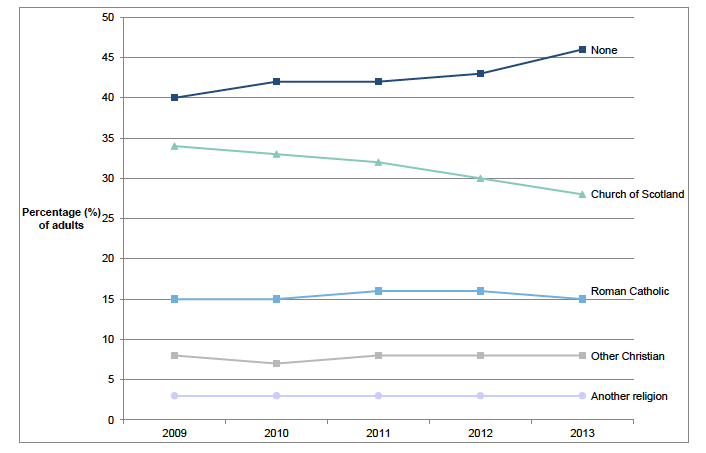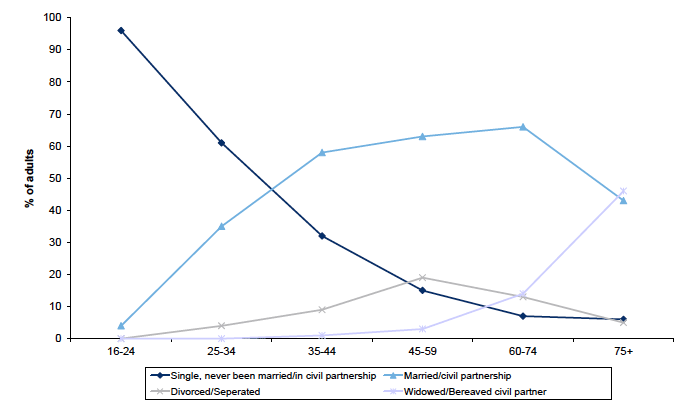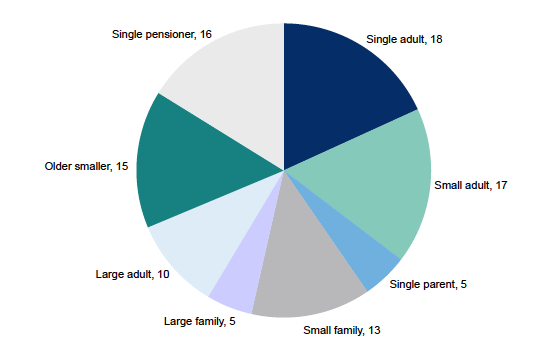Scotland's People Annual Report: Results from 2013 Scottish Household Survey: Revised October 2015
A National Statistics publication for Scotland, providing reliable and up-to-date information on the composition, characteristics, behaviour and attitudes of Scottish households and adults across a number of topic areas including local government, neighbourhoods, health and transport.
2 The Composition and Characteristics of Households and Adults in Scotland
INTRODUCTION AND CONTEXT
The collection of data on protected equality characteristics (age, disability, ethnicity, religion, sex, and sexual orientation) provides an important contribution to the overall equality evidence base, which is used by policy makers to target services and tackle discrimination and disadvantage. The Scottish Household Survey (SHS) collects information about all household members, including children, from the household respondent. This information is used principally for selecting the data of particular groups for further cross-cutting analysis or for use as background variables when analysing other topics.
National Records of Scotland (NRS) use the SHS to publish household estimates based on SHS data. It should be noted though that estimates of total numbers of households derived from the SHS 2013, using the household grossing weight[23], are the same as the 2012 household estimates from NRS[24]. Estimates for particular types of household, as described in this chapter, are likely to differ from NRS due to differences in weighting.
The characteristics of adults and the Highest Income Householder (HIH)[25] are used in this report as variables to examine SHS questions in the chapters that follow. The age and number of people in the household are combined in ‘household type’, a variable which is used to examine the relationship of household composition with a number of different topics throughout this report.
To set the scene for the subsequent analysis, this chapter briefly presents information on selected characteristics of all household members and of adults. It examines household types and considers the relationship between household type and degree of rurality and deprivation.
Main Findings
- Around half (48 per cent) of all adults are married and living with a spouse, while around a third (34 per cent) have never been married or in a civil partnership.
- The majority of adults (96.4 per cent) are of white ethnicity, with ‘White: Scottish’ the predominant ethnic group (79.7 per cent). Four per cent of young adults aged 16 to 24 are married. The majority of adults aged 35 to 44 the majority are married and living with their spouse or in a same sex civil partnership (58 per cent).
- Around a third (34 per cent) of households in Scotland contains only one person, made up of single adults (18 per cent) and single pensioners (16 per cent). Around one quarter of households (23 per cent) are families with children aged under 16.
ALL HOUSEHOLD MEMBERS
The gender and age of all household members, including children, are presented in Table 2.1. There are more female (52 per cent) than male (48 per cent) household members, similar to previous years. Just under a fifth (17 per cent) of household members are aged under 16, while just under a quarter (23 per cent) are 60 or over[26].
Table 2.1: Characteristics of household members
Column percentages, 2013 data
All household members
| Gender | |
|---|---|
| Male | 48 |
| Female | 52 |
| Total | 100 |
| Base | 23,530 |
| Age | Male | Female | All |
|---|---|---|---|
| 0-15 | 18 | 16 | 17 |
| 16-24 | 12 | 11 | 12 |
| 25-34 | 13 | 13 | 13 |
| 35-44 | 13 | 13 | 13 |
| 45-59 | 22 | 21 | 22 |
| 60-74 | 15 | 17 | 16 |
| 75+ | 6 | 8 | 7 |
| Total | 100 | 100 | 100 |
| Base | 11,450 | 12,080 | 23,530 |
ADULTS IN PRIVATE HOUSEHOLDS
Table 2.2 presents equalities characteristics of adults, based on those selected to take part in the ‘random adult’ interview. These tables provide estimates for age, gender, marital status, ethnicity and religion of adults in Scotland.
Just under half (48 per cent) of adults are married and living with a spouse, and less than 1 one per cent are living in a same sex civil partnership. The majority of adults (96.4 per cent) are of white ethnic origin with ‘White: Scottish’ being the predominant ethnic group (79.7 per cent). Adults of Asian ethnicity represented the largest minority ethnic group (2.2 per cent).
Table 2.2: The characteristics of adults
Column percentages, 2013 data
Adults
| Adults | |
|---|---|
| Male | 48 |
| Female | 52 |
| Total | 100 |
| Base | 9,920 |
| Adults | Male | Female | All |
|---|---|---|---|
| 16-24 | 15 | 14 | 14 |
| 25-34 | 16 | 15 | 15 |
| 35-44 | 16 | 16 | 16 |
| 45-59 | 26 | 25 | 26 |
| 60-74 | 19 | 20 | 20 |
| 75+ | 8 | 10 | 9 |
| Total | 100 | 100 | 100 |
| Base | 4,450 | 5,470 | 9,920 |
| Adults | |
|---|---|
| Never married and never registered a same-sex civil partnership | 34 |
| Married | 48 |
| In a registered same-sex civil partnership | 0 |
| Separated, but still legally married | 2 |
| Separated, but still legally in a same-sex civil partnership. | 1 |
| Divorced | 7 |
| Formerly in a same-sex civil partnership which is now legally dissolved. | 0 |
| Widowed | 8 |
| Surviving partner from a same-sex civil partnership | 0 |
| Total | 100 |
| Base | 9,920 |
| Ethnicity | |
|---|---|
| White | 96.4 |
| Scottish | 79.7 |
| Other British | 12.1 |
| Irish | 1.1 |
| Polish | 1.2 |
| Other white ethnic group | 2.3 |
| Any Mixed or Multiple Ethnic Groups | 0.2 |
| Asian, Asian Scottish or Asian British | 2.2 |
| Pakistani, Pakistani Scottish or Pakistani British | 0.7 |
| Indian, Indian Scottish or Indian British | 0.7 |
| Bangladeshi, Bangladeshi Scottish or Bangladeshi British | 0.0 |
| Chinese, Chinese Scottish or Chinese British | 0.5 |
| Other Asian ethnic group | 0.3 |
| African | 0.4 |
| African, African Scottish or African British | 0.3 |
| Other African ethnic group | 0.1 |
| Caribbean or Black | 0.1 |
| Caribbean, Caribbean Scottish or Caribbean British | 0.0 |
| Black, Black Scottish or Black British | 0.0 |
| Other Caribbean or Black ethnic group | - |
| Other Ethnic Group | 0.7 |
| Arab, Arab Scottish or Arab British | 0.0 |
| Any other ethnic group (please say what) | 0.6 |
| Total | 100 |
| Base | 9,920 |
| Adults | |
|---|---|
| None | 46.1 |
| Church of Scotland | 28.4 |
| Roman Catholic | 15.1 |
| Other Christian | 7.6 |
| Muslim | 1.2 |
| Buddhist | 0.2 |
| Sikh | 0.1 |
| Jewish | 0.1 |
| Hindu | 0.3 |
| Pagan | 0.1 |
| Another religion, please write in | 0.7 |
| Total | 100 |
| Base | 9,920 |
Since the harmonised[27] religion question was introduced to the SHS in 2009, there has been an upward trend in the proportion of adults reporting not having a religion, from 40 per cent in 2009 to 46 per cent in 2013. There has also been a corresponding decrease in the proportion reporting ‘Church of Scotland’, from 34 per cent to 28 per cent.
Figure 2.1: Religion of adults by year
2013 data, Adults (base minimum: 9,890)

Figure 2.2 shows the relationships between current marital status and adults of different ages. Of those adults aged 16 to 24 in 2013, the vast majority (96 per cent) have never been married or been in a same sex civil partnership. For those in the age bands between 35 to 74, marriage is the predominant status and accounts for 63 per cent of adults across these categories. The proportion married or in a civil partnership then drops off slightly for those aged 75 or over (43 per cent) with a similar proportion (46 per cent) in this age group reporting being widowed or a bereaved civil partner.
Figure 2.2: Current marital status of adults by age
2013 data, Adults (base minimum: 830)

The data underlying Figure 2.2 are presented in Table 2.3 in more detail. As well as showing the percentages of each age group who are married, divorced etc.[28], it also shows the percentage of each marital status category who are aged 16 to 24, 25 to 34 and so on[29].
Table 2.3: Marital status and age of adult population
Column and row percentages, 2013 data
| Adults | 16-24 | 25-34 | 35-44 | 45-59 | 60-74 | 75+ | All |
|---|---|---|---|---|---|---|---|
| Single, never been married/in civil partnership | 96 | 61 | 32 | 15 | 7 | 6 | 34 |
| Married/civil partnership | 4 | 35 | 58 | 63 | 66 | 43 | 48 |
| Divorced/Seperated | 0 | 4 | 9 | 19 | 13 | 5 | 10 |
| Widowed/Bereaved civil partner | - | - | 1 | 3 | 14 | 46 | 8 |
| Total | 100 | 100 | 100 | 100 | 100 | 100 | 100 |
| Base | 830 | 1,350 | 1,450 | 2,590 | 2,400 | 1,300 | 9,920 |
| Adults | 16-24 | 25-34 | 35-44 | 45-59 | 60-74 | 75+ | Total | Base |
|---|---|---|---|---|---|---|---|---|
| Single, never been married/in civil partnership | 40 | 28 | 15 | 12 | 4 | 2 | 100 | 3,040 |
| Married/civil partnership | 1 | 11 | 19 | 33 | 27 | 8 | 100 | 4,160 |
| Divorced/Seperated | 0 | 6 | 15 | 48 | 26 | 5 | 100 | 1,410 |
| Widowed/Bereaved civil partner | - | - | 1 | 10 | 36 | 53 | 100 | 1,310 |
| All | 14 | 15 | 16 | 26 | 20 | 9 | 100 | 9,920 |
The question on sexual orientation was introduced to the SHS in 2011 as one of the Scottish Government’s “core" questions.[30] Developed by the Office for National Statistics[31], the question was designed to provide accurate statistics to underpin the equality monitoring responsibilities of public sector organisations and to assess the disadvantage or relative discrimination experienced by the lesbian, gay and bisexual population. See notes on self-identified sexual orientation in Annex 2 for further information on the data limitations.
Table 2.4 shows that 98.6 per cent of adults identified themselves as heterosexual or straight. A further 0.6 per cent of adults refused or preferred not to answer the question. The ‘other’ option addresses the fact that not all people will fall in the three main categories.
Table 2.4: Sexual orientation by gender
Column percentages, 2013 data
| Adults | Male | Female | All |
|---|---|---|---|
| Heterosexual/Straight | 98.5 | 98.7 | 98.6 |
| Gay/Lesbian | 0.7 | 0.4 | 0.6 |
| Bisexual | 0.2 | 0.2 | 0.2 |
| Other | 0 | 0 | 0 |
| Refused | 0.6 | 0.7 | 0.6 |
| Total | 100 | 100 | 100 |
| Base | 4,450 | 5,470 | 9,920 |
It should be noted that estimates on self-identified sexual orientation from the SHS are likely to under-represent the lesbian, gay and bisexual population. Potential reasons for this are discussed in Annex 2.
HOUSEHOLD TYPE
Household type is derived from the details collected from the household respondent about all household members, using a combination of age and number of people in the household. Full definitions of each household type are included in the Glossary (Annex 2). Combining the data in this way provides an indicator of the life stage and family circumstance of households.
Figure 2.3 shows that just over a third of households in Scotland contain only one adult living alone, split as 18 per cent in single adult households and 16 per cent in single pensioner households. Small families without children also account for one-third of households (small adult, older smaller), while around a quarter (23 per cent) are families with children aged under 16 (single parent, small family, large family).
2013 data, Households (base: 10,650)

Table 2.5 shows the extent to which household type varies according to degree of rurality[32]. The differences between different types of area are relatively small, but some can be seen between large urban areas and Scotland as a whole, with large urban areas having higher than average levels of single adults (22 per cent) and lower than average levels of older smaller households (11 per cent).
Table 2.5: Household type by Urban Rural Classification
Column percentages, 2013 data
| Households | Large urban areas | Other urban areas | Accessible small towns | Remote small towns | Accessible rural | Remote rural | All |
|---|---|---|---|---|---|---|---|
| Single adult | 22 | 17 | 14 | 22 | 14 | 13 | 18 |
| Small adult | 18 | 16 | 18 | 13 | 18 | 14 | 17 |
| Single parent | 5 | 6 | 5 | 3 | 4 | 3 | 5 |
| Small family | 12 | 13 | 13 | 11 | 14 | 14 | 13 |
| Large family | 4 | 6 | 6 | 6 | 7 | 6 | 5 |
| Large adult | 10 | 10 | 10 | 12 | 8 | 9 | 10 |
| Older smaller | 11 | 16 | 17 | 16 | 20 | 24 | 15 |
| Single pensioner | 17 | 16 | 17 | 17 | 15 | 17 | 16 |
| Total | 100 | 100 | 100 | 100 | 100 | 100 | 100 |
| Base | 3,570 | 3,230 | 970 | 650 | 1,150 | 1,080 | 10,650 |
There are also links between levels of deprivation and household type (Table 2.6). In particular, the proportion of single adult and single parent households increases with increasing deprivation (24 per cent and 9 per cent, respectively, in the 20 per cent most deprived areas). This might be because with one adult of working age, these household are likely to have lower incomes and therefore housing options in the most deprived areas will be more affordable to them.
Table 2.6: Household type by Scottish Index of Multiple Deprivation quintiles (SIMD)
Column percentages, 2013 data
| Households | 1 - Most Deprived | 2 | 3 | 4 | 5 - Least Deprived | All |
|---|---|---|---|---|---|---|
| Single adult | 24 | 21 | 19 | 16 | 12 | 18 |
| Small adult | 14 | 17 | 18 | 18 | 19 | 17 |
| Single parent | 9 | 7 | 4 | 3 | 2 | 5 |
| Small family | 12 | 10 | 13 | 14 | 15 | 13 |
| Large family | 5 | 4 | 5 | 7 | 6 | 5 |
| Large adult | 7 | 10 | 10 | 10 | 12 | 10 |
| Older smaller | 11 | 14 | 15 | 19 | 18 | 15 |
| Single pensioner | 17 | 19 | 16 | 14 | 15 | 16 |
| Total | 100 | 100 | 100 | 100 | 100 | 100 |
| Base | 2,020 | 2,140 | 2,320 | 2,260 | 1,910 | 10,650 |
Contact
Email: Andrew Craik
There is a problem
Thanks for your feedback